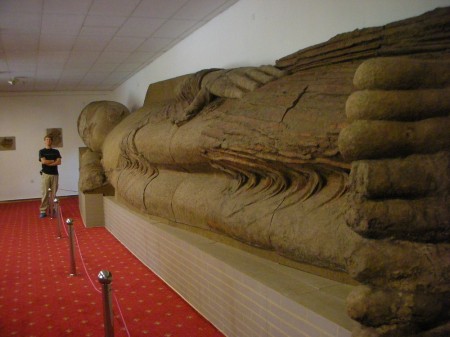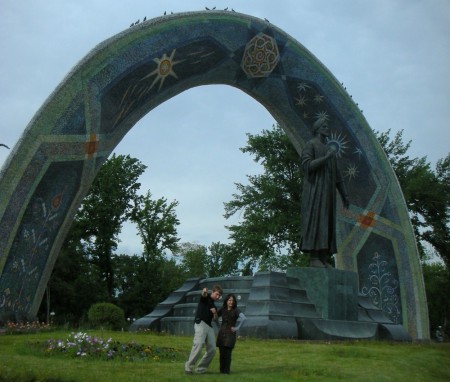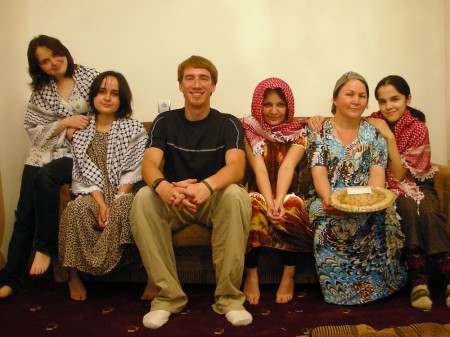The plane arrived at the silent, tree-lined Dushanbe runway at approximately ten past three in the morning, spilling its tired passengers out onto the tarmac where a bus quietly transported us to the small airport main building. Although all flights into Dushanbe from the west come in at this hour, the airport had only posted two officers to handle passports and visas. I waited in line with everyone else for about half an hour, wondering if I had everything I needed in order to get into the country. Besides the dozen Tajiks in the group who were quickly processed and entered, the rest of the passengers mainly looked to be made up of American and British business contractors who talked quietly with each other with the bored air of those who have been in airports far smaller at far earlier hours.
Suddenly, through the crowds, I spotted Malik, my host and father of my exchange “sister,” Farahnush. He waved to me eagerly from the other side of the turnstiles and I left the line to embrace him. “Did you pick up your visa yet?” he asked expectantly, seeing that I was waiting in the passport-check line. “Uh,” I replied helpfully, to which Malik produced a stack of papers and told me to go through a rough wooden door on the far wall, which I had actually thought was a bathroom or a closet.
For the next hour, I was shuffled between various desks of tired-looking officials, who glanced at my paperwork, made some marks on it, and then dropped it into another pile. Malik came in to join me at some point in my vigil, and his fast, musical-sounding Tajik conversation with the clerks sped things up. He and I were surprised to learn that my entry visa would cost me $57, instead of $15 which we had originally thought. It wouldn’t be until the next day that we would discover that they had charged us for a Commercial-level visa, as opposed to the Tourism-level visa which I was supposed to receive. We should have paid closer attention to what the crafty airport officials were sticking into my passport.
At long last, we were free of the airport and Malik and I drove to his home through the darkened streets of Dushanbe. The sun was just starting to rise, dimly illuminating the wide streets and the huge hanging willows and Chinnar trees over them. I noted that people, dressed conservatively in long, flowing clothing, were sweeping out the gutters on each street with brooms made of branches and twigs. As the first light of the sun broke over the mountains surrounding the city, the Russian/Tajik billboards along the sides of the road became readable (but not translatable for me) as we pulled up to the apartment.
Although it was almost 5 in the morning, I was greeted affectionately at the door by Farahnush and her mother, Reihan, who although having never met me before, embraced me warmly and welcomed me to their home. Farahnush, who has no biological brothers but three sisters, was very happy to see me as well, although she was worried about why we had taken so long at the airport! Although Farahnush and Malik are the only ones in the family that speak English fluently, they had no difficulty translating our passport troubles to Reihan, who shook her head and tsk’d disapprovingly. I was escorted into their warm kitchen and was fed baklava with honey, juice, and candy, then directed towards my bedroom, where I collapsed instantly, practically on top of my luggage, and slept deeply until 11.
When I awoke, I began the day properly by touring Dushanbe with Farahnush and Malik. Our first stop was lunch at a Choykhona, which is Tajik for “Teahouse,” the standard café which forms a central part of Tajik community, business, and life. Every city or village in the country, no matter how small, has a teahouse, and so it made sense that Dushanbe chose to send their sister city of Boulder, Colorado, an elaborate and ornately-decorated teahouse. My family visited this teahouse last summer while Farahnush was still with us, and it was interesting to see how closely the food, drink, and culture differed from its American descendant. One thing I find particularly interesting about the teahouse culture is its close connection with flowing water, which can almost always be found near a teahouse in some form. In the case of this teahouse, our tables were suspended over a stream which trickled by musically underneath us as we ate kebabs, mulberries and round loaves of bread while drinking the traditional choy seeoh; black tea.
Wisconsin has a lot of trees, but during my time in Jordan I had almost forgotten what it was like to walk down a cool, shady-green street with hundreds of ancient trees hanging over you. Another characteristic of all Tajik towns is the wide, deep gutters on either side of each road, which you can usually count on being filled with rushing water from somewhere in the town, which in turn allows the trees along the curbs to flourish. The three of us next visited a history museum, containing artifacts, clothing, and armor from thousands of years of Tajik culture. Most impressive was the massive 10-meter long statue of a reclining Buddha that was discovered only recently in northern Tajikistan; a stone figure so large that he had to be sliced into pieces in order to get him into the museum where he could be reassembled.
Back at home, I met the rest of the family; Farahnush’s elder sisters Sayora and Shazoda, and her little sister Tahmina. After dinner, I presented my adopted family with gifts I had brought for them from Jordan – red Jordanian and black Palestinian keffiyehs, and Jordanian baklava from downtown Amman. Like me, 24-year-old Sayora apparently has a political streak in her, and her eyes lit up when Malik translated to them that the keffiyehs had Palestinian connections and she pounced on one happily, while I told her that wearing that in Jordan will automatically put you on the side of the Palestinians, which she seemed very pleased about.
The final event of the evening was a party at the American Embassy of Tajikistan, at which Malik is an employee. Malik brought Shazoda (clad in the other black keffiyeh) and me to the gates, where we were led through a pink rose garden and to the Marine guards’ barracks. As in all embassies (of the American variety at least), cameras were confiscated at the front desk for security reasons, or else I would have pictures to show you. The American and British football teams were having a match that evening, as well as live music provided by a British band (who also kindly picked up everyone’s bar tab). I sampled Russian beer for the first time and met several interesting international businessmen and world travelers. I was in such a rush of meeting everyone that Malik led me towards that I didn’t even catch the name of the energetic, slender woman who bounded about greeting people as they arrived and shouting words of encouragement to the competing sports teams. She was pleased to hear that I was a teacher in Jordan, working with refugees, and she strongly encouraged me to look into the Foreign Service if I was interested in continuing my work overseas. It wasn’t until later when someone else mentioned, “So you met the Madame Ambassador?” that I realized that I had been talking with Tracey Jacobson, the American ambassador herself!





Don’t worry, your hard work hasn’t gone unappreciated. See, I read your blog.